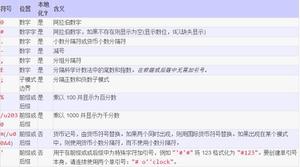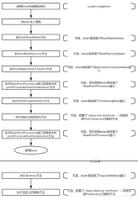框架源码系列十:Spring AOP(AOP的核心概念回顾、Spring中AOP的用法、Spring AOP 源码学习)
本文内容纲要:
- 一、AOP的核心概念回顾- 二、Spring中AOP的用法
- 1. 传统Advisor方式
- 2. Aspect语法方式
- Aspect的advice是基于方法的。
- 3. AspectJ注解方式
- 三、Spring AOP 源码学习
- 1、spring aop的工作流程是怎样?以传统的Advisor配置为例进行思考
- 2. 源码阅读思路
- 1、先看配置解析,看标签解析过程都做了什么、完成了什么。
- 2、 看织入的过程
- 3 、看方法被调用时的增强过程
- 4、源码对应的类图
一、AOP的核心概念回顾
https://docs.spring.io/spring/docs/5.1.3.RELEASE/spring-framework-reference/core.html#aop
我们先来看一下下面的这张图
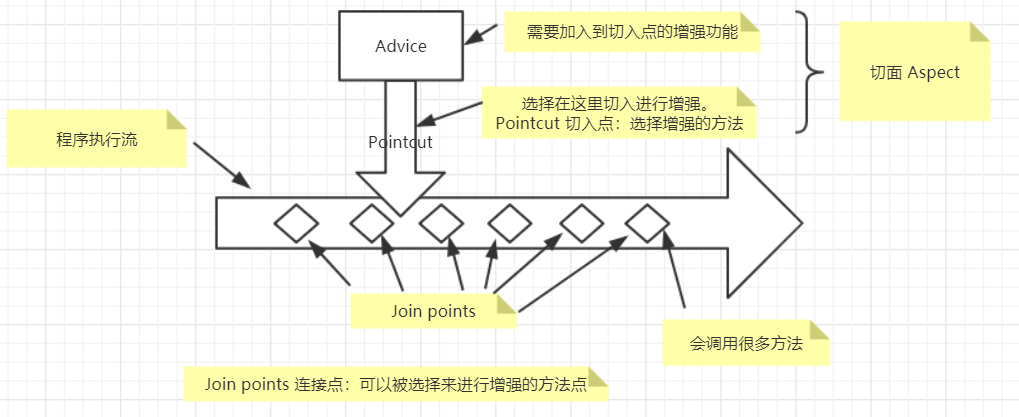
说明:
程序运行时会调用很多方法,调用的很多方法就叫做Join points(连接点,可以被选择来进行增强的方法点),在方法的前或者后选择一个地方来切入,切入的的地方就叫做Pointcut(切入点,选择增强的方法),然后把要增强的功能(Advice)加入到切入点所在的位置。Advice和Pointcut组成一个切面(Aspect)
AOP的几个概念:
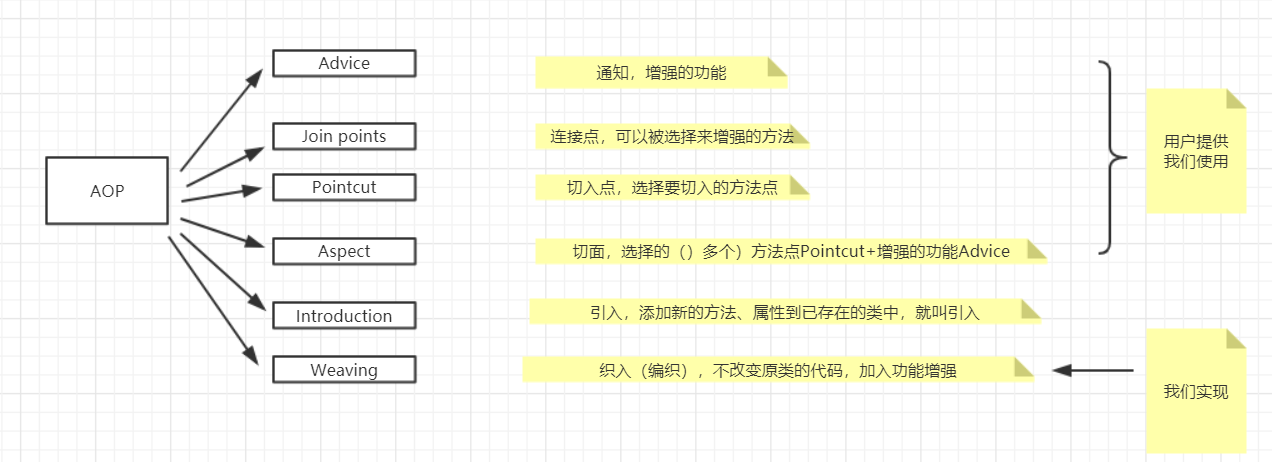
Advice、Pointcut、Weaving的特点:
Advice(功能增强):
1)用户性:由用户提供增强功能的逻辑代码
2)变化的:不同的增强需求,会有不同的逻辑
3)可选时机:可选择在方法前、后、异常时进行功能增强
4)多重的:同一个切入点上可以有多重增强
Pointcut(切入点):
1)用户性:由用户来指定
2)变化的:用户可灵活指定
3)多点性:用户可以选择在多个点上进行功能增强
Weaving(织入):
1)无侵入性,因为不改变原类的代码
2)我们在框架中实现
二、Spring中AOP的用法
1. 传统Advisor方式
掌握用法:
1)编程提供Advice,实现对应的Advice接口
2)配置Advisor(advice+pointcut)
Advice接口:

示例代码:
被增强的目标对象:
BeanQ
package com.study.leesmall.spring.sample.aop;//被增强的目标对象
public class BeanQ {
public void do1(String task, int time) {
System.out.println("-------------do1 do " + task + " time:" + time);
}
public String service1(String name) {
System.out.println("-------------servce1 do " + name);
return name;
}
public String service2(String name) {
System.out.println("-------------servce2 do " + name);
if (!"s1".equals(name)) {
throw new IllegalArgumentException("参数 name != s1, name=" + name);
}
return name + " hello!";
}
}
编程提供Advice,实现对应的Advice接口:
前置增强:
MyBeforeAdvice
package com.study.leesmall.spring.sample.aop;import java.lang.reflect.Method;
import org.springframework.aop.MethodBeforeAdvice;
//前置增强
public class MyBeforeAdvice implements MethodBeforeAdvice {
@Override
public void before(Method method, Object[] args, Object target) throws Throwable {
System.out.println("------ MyBeforeAdvice before 增强 " + target + " " + method);
}
}
环绕增强:
MyArroundAdvice
package com.study.leesmall.spring.sample.aop;import org.aopalliance.intercept.MethodInterceptor;
import org.aopalliance.intercept.MethodInvocation;
//环绕增强
public class MyArroundAdvice implements MethodInterceptor {
@Override
public Object invoke(MethodInvocation invocation) throws Throwable {
System.out.println("--------- 环绕 -前增强");
Object ret = invocation.proceed();
System.out.println("--------- 环绕 -后增强");
return ret;
}
}
在/spring-source-study/src/main/java/com/study/leesmall/spring/sample/aop/application.xml里面配置Advisor(advice+pointcut):
<?xml version="1.0" encoding="UTF-8"?><beans xmlns="http://www.springframework.org/schema/beans"
xmlns:xsi="http://www.w3.org/2001/XMLSchema-instance"
xmlns:context="http://www.springframework.org/schema/context"
xmlns:aop="http://www.springframework.org/schema/aop"
xsi:schemaLocation="http://www.springframework.org/schema/beans
http://www.springframework.org/schema/beans/spring-beans.xsd
http://www.springframework.org/schema/context
http://www.springframework.org/schema/context/spring-context.xsd
http://www.springframework.org/schema/aop
http://www.springframework.org/schema/aop/spring-aop.xsd">
<!-- 传统方式的aop begin -->
<!--被增强的目标对象 -->
<bean id="BeanQ" class="com.study.leesmall.spring.sample.aop.BeanQ" />
<!--配置advice -->
<bean id="myBeforeAdvice" class="com.study.leesmall.spring.sample.aop.MyBeforeAdvice" />
<bean id="yyArroundAdvice" class="com.study.leesmall.spring.sample.aop.MyArroundAdvice" />
<!--配置pointcut -->
<aop:config >
<!--全局切入点,任何一个aop-config都可以使用 -->
<aop:pointcut id="doMethods" expression="execution(* com.study.leesmall.spring.sample.aop.*.do*(..))" />
<aop:advisor advice-ref="myBeforeAdvice" pointcut-ref="doMethods" />
<aop:advisor advice-ref="yyArroundAdvice"
pointcut="execution(* com.study.leesmall.spring.sample.aop.*.service*(..))"/>
</aop:config>
<!-- 传统方式的aop end -->
</beans>
配置文件里面的注意点:
aop:config 的属性了解
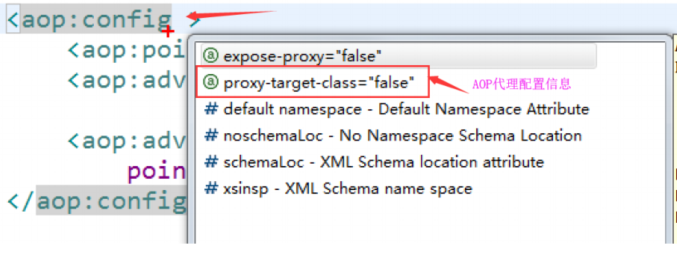
proxy-target-class="false"使用jdk的动态代理 默认配置proxy-target-class="true"使用cglib的动态代理
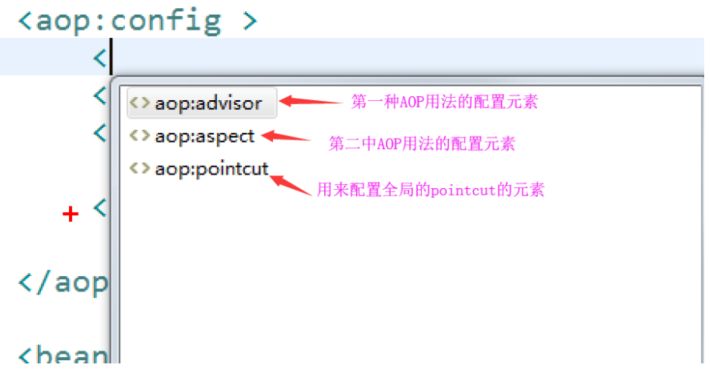
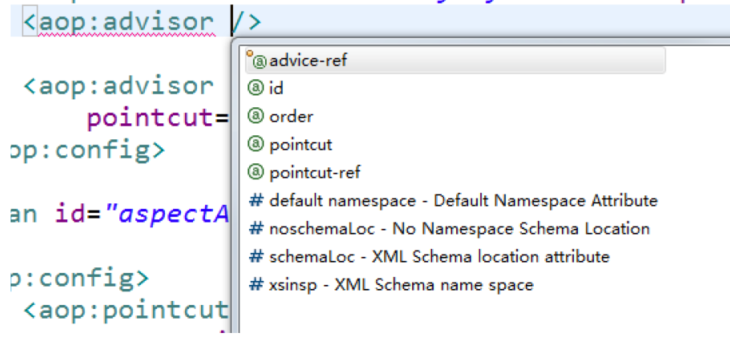
掌握 spring Aop 的 API:
Advice:

Advisor的代码:
* Copyright 2002-2017 the original author or authors.package org.springframework.aop;
import org.aopalliance.aop.Advice;
/**
* Base interface holding AOP <b>advice</b> (action to take at a joinpoint)
* and a filter determining the applicability of the advice (such as
* a pointcut). <i>This interface is not for use by Spring users, but to
* allow for commonality in support for different types of advice.</i>
*
* <p>Spring AOP is based around <b>around advice</b> delivered via method
* <b>interception</b>, compliant with the AOP Alliance interception API.
* The Advisor interface allows support for different types of advice,
* such as <b>before</b> and <b>after</b> advice, which need not be
* implemented using interception.
*
* @author Rod Johnson
* @author Juergen Hoeller
*/
public interface Advisor {
/**
* Common placeholder for an empty {@code Advice} to be returned from
* {@link #getAdvice()} if no proper advice has been configured (yet).
* @since 5.0
*/
Advice EMPTY_ADVICE = new Advice() {};
/**
* Return the advice part of this aspect. An advice may be an
* interceptor, a before advice, a throws advice, etc.
* @return the advice that should apply if the pointcut matches
* @see org.aopalliance.intercept.MethodInterceptor
* @see BeforeAdvice
* @see ThrowsAdvice
* @see AfterReturningAdvice
*/
Advice getAdvice();
/**
* Return whether this advice is associated with a particular instance
* (for example, creating a mixin) or shared with all instances of
* the advised class obtained from the same Spring bean factory.
* <p><b>Note that this method is not currently used by the framework.</b>
* Typical Advisor implementations always return {@code true}.
* Use singleton/prototype bean definitions or appropriate programmatic
* proxy creation to ensure that Advisors have the correct lifecycle model.
* @return whether this advice is associated with a particular target instance
*/
boolean isPerInstance();
}
Pointcut:
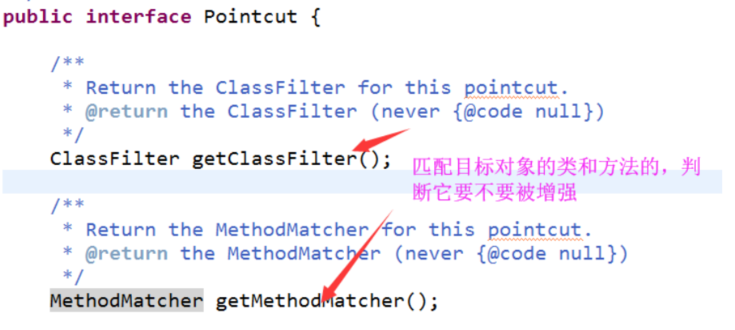
Pointcut的子类:

Advisor的子类:

PointcutAdvisor扩展了Advisor以后就会有一个切面Aspect=Advice+Pointcut
PointcutAdvisor的代码:
* Copyright 2002-2012 the original author or authors.package org.springframework.aop;
/**
* Superinterface for all Advisors that are driven by a pointcut.
* This covers nearly all advisors except introduction advisors,
* for which method-level matching doesn't apply.
*
* @author Rod Johnson
*/
public interface PointcutAdvisor extends Advisor {
/**
* Get the Pointcut that drives this advisor.
*/
Pointcut getPointcut();
}
PointcutAdvisor的子类:

测试类:
AopMain
package com.study.leesmall.spring.sample.aop;import org.springframework.context.ApplicationContext;
import org.springframework.context.support.GenericXmlApplicationContext;
public class AopMain {
public static void main(String[] args) {
ApplicationContext context = new GenericXmlApplicationContext(
"classpath:com/study/leesmall/spring/sample/aop/application.xml");
BeanQ bq = context.getBean(BeanQ.class);
bq.do1("task1", 20);
System.out.println();
bq.service1("service1");
System.out.println();
bq.service2("ssss");
}
}
测试结果:
------ MyBeforeAdvice before 增强 com.study.leesmall.spring.sample.aop.BeanQ@1d119efb public void com.study.leesmall.spring.sample.aop.BeanQ.do1(java.lang.String,int)-------------do1 do task1 time:20
--------- 环绕 -前增强
-------------servce1 do service1
--------- 环绕 -后增强
--------- 环绕 -前增强
-------------servce2 do ssss
Exception in thread "main" java.lang.IllegalArgumentException: 参数 name != s1, name=ssss
at com.study.leesmall.spring.sample.aop.BeanQ.service2(BeanQ.java:18)
at com.study.leesmall.spring.sample.aop.BeanQ$$FastClassBySpringCGLIB$$3d1515ac.invoke(<generated>)
at org.springframework.cglib.proxy.MethodProxy.invoke(MethodProxy.java:218)
at org.springframework.aop.framework.CglibAopProxy$CglibMethodInvocation.invokeJoinpoint(CglibAopProxy.java:749)
at org.springframework.aop.framework.ReflectiveMethodInvocation.proceed(ReflectiveMethodInvocation.java:163)
at com.study.leesmall.spring.sample.aop.MyArroundAdvice.invoke(MyArroundAdvice.java:12)
at org.springframework.aop.framework.ReflectiveMethodInvocation.proceed(ReflectiveMethodInvocation.java:186)
at org.springframework.aop.interceptor.ExposeInvocationInterceptor.invoke(ExposeInvocationInterceptor.java:93)
at org.springframework.aop.framework.ReflectiveMethodInvocation.proceed(ReflectiveMethodInvocation.java:186)
at org.springframework.aop.framework.CglibAopProxy$DynamicAdvisedInterceptor.intercept(CglibAopProxy.java:688)
at com.study.leesmall.spring.sample.aop.BeanQ$$EnhancerBySpringCGLIB$$2fc5343.service2(<generated>)
at com.study.leesmall.spring.sample.aop.AopMain.main(AopMain.java:18)
2. Aspect语法方式
Aspect的advice是基于方法的。
掌握用法:
1)定义包含Advice方法的Bean类
2)配置Bean定义
3)配置Aspect(引用包含advice方法的bean),在里面配置各种Advice(method+pointcut)
定义包含Advice方法的Bean类:
AspectAdviceBean:
package com.study.leesmall.spring.sample.aop;import org.aspectj.lang.JoinPoint;
import org.aspectj.lang.ProceedingJoinPoint;
//定义包含 Advice 方法的 Bean 类
public class AspectAdviceBean {
public void before1() {
System.out.println("----------- AspectAdviceBean before1 增强 ");
}
//JoinPoint看具体哪个方法被增强了,JoinPoint一定要放在第一个参数
public void before2(JoinPoint jp) {
System.out.println("----------- AspectAdviceBean before2 增强 for " + jp);
}
//调用被增强的方法时传参数
//<aop:before method="before3" pointcut="execution(* com.study.leesmall.spring.sample.aop.*.do*(..))
//and args(tk,..)" arg-names=""/>
//args(tk,..)有两个意思,第一个意思是被增强的方法的第一个参数的类型要和before3的参数tk的类型一样
//第二个意思是被增强的方法的第一个参数tk要赋值给before3的参数tk
//arg-names="" 当不能确定方法参数的顺序时可以用这个参数指定arg-names="param1,param2"
public void before3(String tk) {
System.out.println("----------- AspectAdviceBean before3 增强 参数tk= " + tk);
}
//调用被增强的方法时传参数
public void before4(String tk, int ti) {
System.out.println("----------- AspectAdviceBean before4 增强 参数tk= " + tk + " ti=" + ti);
}
//ProceedingJoinPoint正在处理的方法
public Object arround1(ProceedingJoinPoint pjp) throws Throwable {
System.out.println("----------- AspectAdviceBean arround1 环绕-前增强 for " + pjp);
Object ret = pjp.proceed();
System.out.println("----------- AspectAdviceBean arround1 环绕-后增强 for " + pjp);
return ret;
}
public Object arround2(ProceedingJoinPoint pjp, String name) throws Throwable {
System.out.println("--------- AspectAdviceBean arround2 参数 name=" + name);
System.out.println("----------- AspectAdviceBean arround2 环绕-前增强 for " + pjp);
Object ret = pjp.proceed();
System.out.println("----------- AspectAdviceBean arround2 环绕-后增强 for " + pjp);
return ret;
}
public void afterReturning(Object retValue) {
System.out.println("----------- AspectAdviceBean afterReturning 增强 , 返回值为: " + retValue);
}
public void afterThrowing(JoinPoint jp, Exception e) {
System.out.println("----------- AspectAdviceBean afterThrowing 增强 for " + jp);
System.out.println("----------- AspectAdviceBean afterThrowing 增强 异常 :" + e);
}
public void after(JoinPoint jp) {
System.out.println("----------- AspectAdviceBean after 增强 for " + jp);
}
}
JoinPoint和ProceedingJoinPoint :
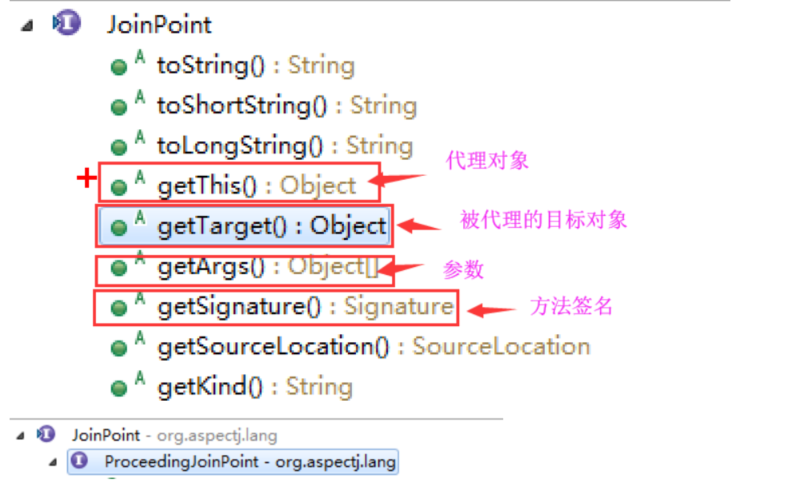
在/spring-source-study/src/main/java/com/study/leesmall/spring/sample/aop/application.xml里面配置Bean定义
<?xml version="1.0" encoding="UTF-8"?><beans xmlns="http://www.springframework.org/schema/beans"
xmlns:xsi="http://www.w3.org/2001/XMLSchema-instance"
xmlns:context="http://www.springframework.org/schema/context"
xmlns:aop="http://www.springframework.org/schema/aop"
xsi:schemaLocation="http://www.springframework.org/schema/beans
http://www.springframework.org/schema/beans/spring-beans.xsd
http://www.springframework.org/schema/context
http://www.springframework.org/schema/context/spring-context.xsd
http://www.springframework.org/schema/aop
http://www.springframework.org/schema/aop/spring-aop.xsd">
<!-- 传统方式的aop begin -->
<!--被增强的目标对象 -->
<bean id="BeanQ" class="com.study.leesmall.spring.sample.aop.BeanQ" />
<!--配置advice -->
<bean id="myBeforeAdvice" class="com.study.leesmall.spring.sample.aop.MyBeforeAdvice" />
<bean id="yyArroundAdvice" class="com.study.leesmall.spring.sample.aop.MyArroundAdvice" />
<!--配置pointcut -->
<aop:config >
<aop:pointcut id="doMethods" expression="execution(* com.study.leesmall.spring.sample.aop.*.do*(..))" />
<aop:advisor advice-ref="myBeforeAdvice" pointcut-ref="doMethods" />
<aop:advisor advice-ref="yyArroundAdvice"
pointcut="execution(* com.study.leesmall.spring.sample.aop.*.service*(..))"/>
</aop:config>
<!-- 传统方式的aop end -->
<!-- AspectJ的aop begin -->
<!-- 配置了包含advice方法的Bean -->
<bean id="aspectAdviceBean" class="com.study.leesmall.spring.sample.aop.AspectAdviceBean" />
</beans>
3)配置Aspect(引用包含advice方法的bean),在里面配置各种Advice(method+pointcut)
<?xml version="1.0" encoding="UTF-8"?><beans xmlns="http://www.springframework.org/schema/beans"
xmlns:xsi="http://www.w3.org/2001/XMLSchema-instance"
xmlns:context="http://www.springframework.org/schema/context"
xmlns:aop="http://www.springframework.org/schema/aop"
xsi:schemaLocation="http://www.springframework.org/schema/beans
http://www.springframework.org/schema/beans/spring-beans.xsd
http://www.springframework.org/schema/context
http://www.springframework.org/schema/context/spring-context.xsd
http://www.springframework.org/schema/aop
http://www.springframework.org/schema/aop/spring-aop.xsd">
<!-- 传统方式的aop begin -->
<!--被增强的目标对象 -->
<bean id="BeanQ" class="com.study.leesmall.spring.sample.aop.BeanQ" />
<!--配置advice -->
<bean id="myBeforeAdvice" class="com.study.leesmall.spring.sample.aop.MyBeforeAdvice" />
<bean id="yyArroundAdvice" class="com.study.leesmall.spring.sample.aop.MyArroundAdvice" />
<!--配置pointcut -->
<aop:config >
<aop:pointcut id="doMethods" expression="execution(* com.study.leesmall.spring.sample.aop.*.do*(..))" />
<aop:advisor advice-ref="myBeforeAdvice" pointcut-ref="doMethods" />
<aop:advisor advice-ref="yyArroundAdvice"
pointcut="execution(* com.study.leesmall.spring.sample.aop.*.service*(..))"/>
</aop:config>
<!-- 传统方式的aop end -->
<!-- AspectJ的aop begin -->
<!-- 配置了包含advice方法的Bean -->
<bean id="aspectAdviceBean" class="com.study.leesmall.spring.sample.aop.AspectAdviceBean" />
<!--配置 Aspect (引用包含 advice 方法的 bean),在里面配置各种 Advice(method + pointcut) -->
<aop:config>
<aop:pointcut id="services" expression="execution(* com.study.leesmall.spring.sample.aop.*.service*(..))" />
<aop:aspect id="a1" ref="aspectAdviceBean" order="1">
<aop:before method="before1" pointcut-ref="doMethods" />
<aop:before method="before2" pointcut-ref="doMethods"/>
<!--args(tk,..)有两个意思,第一个意思是被增强的方法的第一个参数的类型要和before3的参数tk的类型一样
第二个意思是被增强的方法的第一个参数tk要赋值给before3的参数tk;
arg-names="" 当不能确定方法参数的顺序时可以用这个参数指定arg-names="param1,param2"
-->
<aop:before method="before3" pointcut="execution(* com.study.leesmall.spring.sample.aop.*.do*(..)) and args(tk,..)"/>
<aop:before method="before4" pointcut="execution(* com.study.leesmall.spring.sample.aop.*.do*(..)) and args(tk,ti)"/>
<aop:around method="arround1" pointcut-ref="services"/>
<aop:around method="arround2" pointcut="execution(* com.study.leesmall.spring.sample.aop.*.service*(..)) and args(name)"/>
<aop:after-returning method="afterReturning" pointcut-ref="services" returning="retValue"/>
<aop:after-throwing method="afterThrowing" pointcut-ref="services" throwing="e"/>
<aop:after method="after" pointcut-ref="services"/>
</aop:aspect>
</aop:config>
<!-- AspectJ的aop end -->
</beans>
被增强的目标对象:
package com.study.leesmall.spring.sample.aop;//被增强的目标对象
public class BeanQ {
public void do1(String task, int time) {
System.out.println("-------------do1 do " + task + " time:" + time);
}
public String service1(String name) {
System.out.println("-------------servce1 do " + name);
return name;
}
public String service2(String name) {
System.out.println("-------------servce2 do " + name);
/**if (!"s1".equals(name)) {
throw new IllegalArgumentException("参数 name != s1, name=" + name);
}**/
return name + " hello!";
}
}
测试类:
AopMain
package com.study.leesmall.spring.sample.aop;import org.springframework.context.ApplicationContext;
import org.springframework.context.support.GenericXmlApplicationContext;
public class AopMain {
public static void main(String[] args) {
ApplicationContext context = new GenericXmlApplicationContext(
"classpath:com/study/leesmall/spring/sample/aop/application.xml");
BeanQ bq = context.getBean(BeanQ.class);
bq.do1("task1", 20);
System.out.println();
bq.service1("service1");
System.out.println();
bq.service2("ssss");
}
}
测试结果:
----------- AspectAdviceBean before1 增强 ----------- AspectAdviceBean before2 增强 for execution(void com.study.mike.spring.sample.aop.BeanQ.do1(leesmall,int))
----------- AspectAdviceBean before3 增强 参数tk= task1
----------- AspectAdviceBean before4 增强 参数tk= task1 ti=20
------ MyBeforeAdvice before 增强 com.study.mike.spring.sample.aop.BeanQ@3a0baae5 public void com.study.mike.spring.sample.aop.BeanQ.do1(java.lang.leesmall,int)
-------------do1 do task1 time:20
----------- AspectAdviceBean arround1 环绕-前增强 for execution(leesmall com.study.mike.spring.sample.aop.BeanQ.service1(leesmall))
--------- AspectAdviceBean arround2 参数 name=service1
----------- AspectAdviceBean arround2 环绕-前增强 for execution(leesmall com.study.mike.spring.sample.aop.BeanQ.service1(leesmall))
--------- 环绕 -前增强
-------------servce1 do service1
--------- 环绕 -后增强
----------- AspectAdviceBean arround2 环绕-后增强 for execution(leesmall com.study.mike.spring.sample.aop.BeanQ.service1(leesmall))
----------- AspectAdviceBean arround1 环绕-后增强 for execution(leesmall com.study.mike.spring.sample.aop.BeanQ.service1(leesmall))
----------- AspectAdviceBean afterReturning 增强 , 返回值为: service1
----------- AspectAdviceBean after 增强 for execution(leesmall com.study.mike.spring.sample.aop.BeanQ.service1(leesmall))
----------- AspectAdviceBean arround1 环绕-前增强 for execution(leesmall com.study.mike.spring.sample.aop.BeanQ.service2(leesmall))
--------- AspectAdviceBean arround2 参数 name=ssss
----------- AspectAdviceBean arround2 环绕-前增强 for execution(leesmall com.study.mike.spring.sample.aop.BeanQ.service2(leesmall))
--------- 环绕 -前增强
-------------servce2 do ssss
--------- 环绕 -后增强
----------- AspectAdviceBean arround2 环绕-后增强 for execution(leesmall com.study.mike.spring.sample.aop.BeanQ.service2(leesmall))
----------- AspectAdviceBean arround1 环绕-后增强 for execution(leesmall com.study.mike.spring.sample.aop.BeanQ.service2(leesmall))
----------- AspectAdviceBean afterReturning 增强 , 返回值为: ssss hello!
----------- AspectAdviceBean after 增强 for execution(leesmall com.study.mike.spring.sample.aop.BeanQ.service2(leesmall))
3. AspectJ注解方式
1)先在pom.xml文件里面引入AspectJ的依赖
<dependency> <groupId>org.aspectj</groupId>
<artifactId>aspectjweaver</artifactId>
<version>1.9.1</version>
</dependency>
2)被增强的目标对象
package com.study.leesmall.spring.sample.aop;//被增强的目标对象
public class BeanQ {
public void do1(String task, int time) {
System.out.println("-------------do1 do " + task + " time:" + time);
}
public String service1(String name) {
System.out.println("-------------servce1 do " + name);
return name;
}
public String service2(String name) {
System.out.println("-------------servce2 do " + name);
if (!"s1".equals(name)) {
throw new IllegalArgumentException("参数 name != s1, name=" + name);
}
return name + " hello!";
}
}
3)AspectJ注解方式实现AOP
AspectAdviceBeanUseAnnotation
package com.study.leesmall.spring.sample.aop;import org.aspectj.lang.JoinPoint;
import org.aspectj.lang.ProceedingJoinPoint;
import org.aspectj.lang.annotation.After;
import org.aspectj.lang.annotation.AfterReturning;
import org.aspectj.lang.annotation.AfterThrowing;
import org.aspectj.lang.annotation.Around;
import org.aspectj.lang.annotation.Aspect;
import org.aspectj.lang.annotation.Before;
import org.aspectj.lang.annotation.Pointcut;
//AspectJ注解方式
@Aspect
public class AspectAdviceBeanUseAnnotation {
// 定义一个全局的Pointcut
@Pointcut("execution(* com.study.leesmall.spring.sample.aop.*.do*(..))")
public void doMethods() {
}
// 定义一个全局的Pointcut
@Pointcut("execution(* com.study.leesmall.spring.sample.aop.*.service*(..))")
public void services() {
}
// 定义一个Before Advice
@Before("doMethods() and args(tk,..)")
public void before3(String tk) {
System.out.println("----------- AspectAdviceBeanUseAnnotation before3 增强 参数tk= " + tk);
}
//环绕增强
@Around("services() and args(name,..)")
public Object around2(ProceedingJoinPoint pjp, String name) throws Throwable {
System.out.println("--------- AspectAdviceBeanUseAnnotation arround2 参数 name=" + name);
System.out.println("----------- AspectAdviceBeanUseAnnotation arround2 环绕-前增强 for " + pjp);
Object ret = pjp.proceed();
System.out.println("----------- AspectAdviceBeanUseAnnotation arround2 环绕-后增强 for " + pjp);
return ret;
}
@AfterReturning(pointcut = "services()", returning = "retValue")
public void afterReturning(Object retValue) {
System.out.println("----------- AspectAdviceBeanUseAnnotation afterReturning 增强 , 返回值为: " + retValue);
}
@AfterThrowing(pointcut = "services()", throwing = "e")
public void afterThrowing(JoinPoint jp, Exception e) {
System.out.println("----------- AspectAdviceBeanUseAnnotation afterThrowing 增强 for " + jp);
System.out.println("----------- AspectAdviceBeanUseAnnotation afterThrowing 增强 异常 :" + e);
}
@After("doMethods()")
public void after(JoinPoint jp) {
System.out.println("----------- AspectAdviceBeanUseAnnotation after 增强 for " + jp);
}
}
4)在/spring-source-study/src/main/java/com/study/leesmall/spring/sample/aop/application2.xml里面配置bean和开启AspectJ注解的支持
<?xml version="1.0" encoding="UTF-8"?><beans xmlns="http://www.springframework.org/schema/beans"
xmlns:xsi="http://www.w3.org/2001/XMLSchema-instance"
xmlns:context="http://www.springframework.org/schema/context"
xmlns:aop="http://www.springframework.org/schema/aop"
xsi:schemaLocation="http://www.springframework.org/schema/beans
http://www.springframework.org/schema/beans/spring-beans.xsd
http://www.springframework.org/schema/context
http://www.springframework.org/schema/context/spring-context.xsd
http://www.springframework.org/schema/aop
http://www.springframework.org/schema/aop/spring-aop.xsd">
<!--被增强的目标对象 -->
<bean id="BeanQ" class="com.study.leesmall.spring.sample.aop.BeanQ" />
<!--AspectJ注解方式实现的AOP -->
<bean id="aspectAdviceBeanUseAnnotation" class="com.study.leesmall.spring.sample.aop.AspectAdviceBeanUseAnnotation" />
<!--开启AspectJ注解的支持 -->
<aop:aspectj-autoproxy></aop:aspectj-autoproxy>
</beans>
开启@Aspectj注解方式支持:
Xml中aop:aspectj-autoproxy</aop:aspectj-autoproxy>注意了解它的属性、及子元素
注解方式开启:
@Configuration@EnableAspectJAutoProxy
public class AppConfig {
}
5)测试类
package com.study.leesmall.spring.sample.aop;import org.springframework.context.ApplicationContext;
import org.springframework.context.support.GenericXmlApplicationContext;
public class AopMainUseAspectAnnotation {
public static void main(String[] args) {
ApplicationContext context = new GenericXmlApplicationContext(
"classpath:com/study/leesmall/spring/sample/aop/application2.xml");
BeanQ bq = context.getBean(BeanQ.class);
bq.do1("task1", 20);
System.out.println();
bq.service1("service1");
}
}
7)测试结果
----------- AspectAdviceBeanUseAnnotation before3 增强 参数tk= task1-------------do1 do task1 time:20
----------- AspectAdviceBeanUseAnnotation after 增强 for execution(void com.study.leesmall.spring.sample.aop.BeanQ.do1(String,int))
--------- AspectAdviceBeanUseAnnotation arround2 参数 name=service1
----------- AspectAdviceBeanUseAnnotation arround2 环绕-前增强 for execution(String com.study.leesmall.spring.sample.aop.BeanQ.service1(String))
-------------servce1 do service1
----------- AspectAdviceBeanUseAnnotation arround2 环绕-后增强 for execution(String com.study.leesmall.spring.sample.aop.BeanQ.service1(String))
----------- AspectAdviceBeanUseAnnotation afterReturning 增强 , 返回值为: service1
三、Spring AOP 源码学习
1、spring aop的工作流程是怎样?以传统的Advisor配置为例进行思考
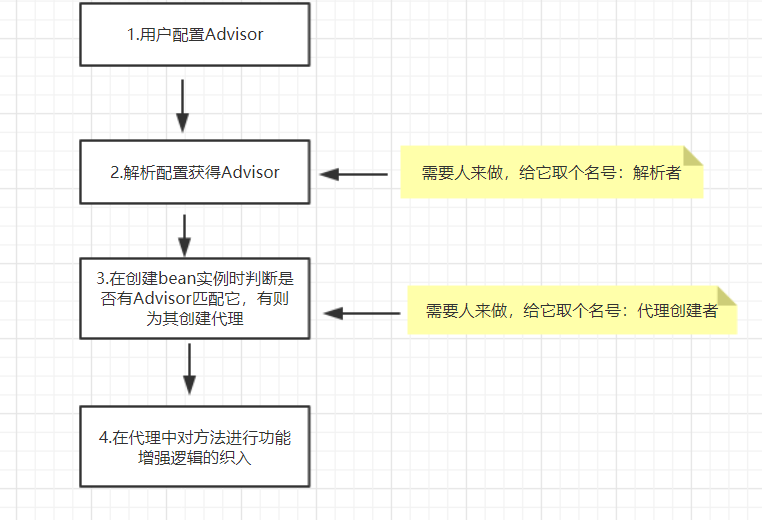
2. 源码阅读思路
1、先看配置解析,看标签解析过程都做了什么、完成了什么。
入口:
E:\repository\org\springframework\spring-aop\5.1.3.RELEASE\spring-aop-5.1.3.RELEASE.jar/META-INF/spring.handlers
http\://www.springframework.org/schema/aop=org.springframework.aop.config.AopNamespaceHandlerorg.springframework.aop.config.AopNamespaceHandler:

a)解析aop:config 及它的子元素
org.springframework.aop.config.ConfigBeanDefinitionParser:

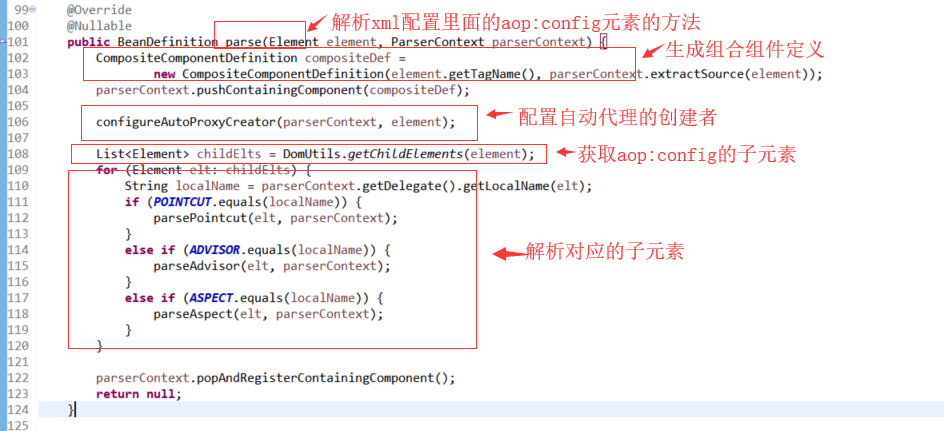
1)注册了autoProxyCreator的Bean定义,它是一个ProxyConfig、BeanFactoryAwrare、BeanPostProcessor
下面来看一下配置自动代理的创建者的代码:
org.springframework.aop.config.ConfigBeanDefinitionParser.configureAutoProxyCreator(ParserContext, Element)
->
org.springframework.aop.config.AopNamespaceUtils.registerAspectJAutoProxyCreatorIfNecessary(ParserContext, Element)
->
org.springframework.aop.config.AopConfigUtils.registerAspectJAutoProxyCreatorIfNecessary(BeanDefinitionRegistry, Object)
->
org.springframework.aop.config.AopConfigUtils.registerOrEscalateApcAsRequired(Class<?>, BeanDefinitionRegistry, Object)

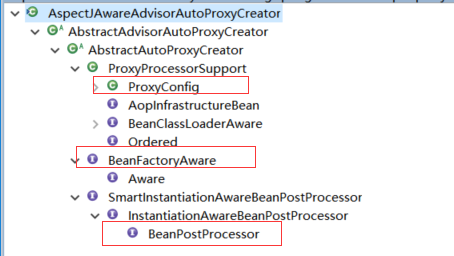
所以说自动代理创建者是一个ProxyConfig、BeanFactoryAwrare、BeanPostProcessor
->
org.springframework.aop.config.AopConfigUtils.findPriorityForClass(String)
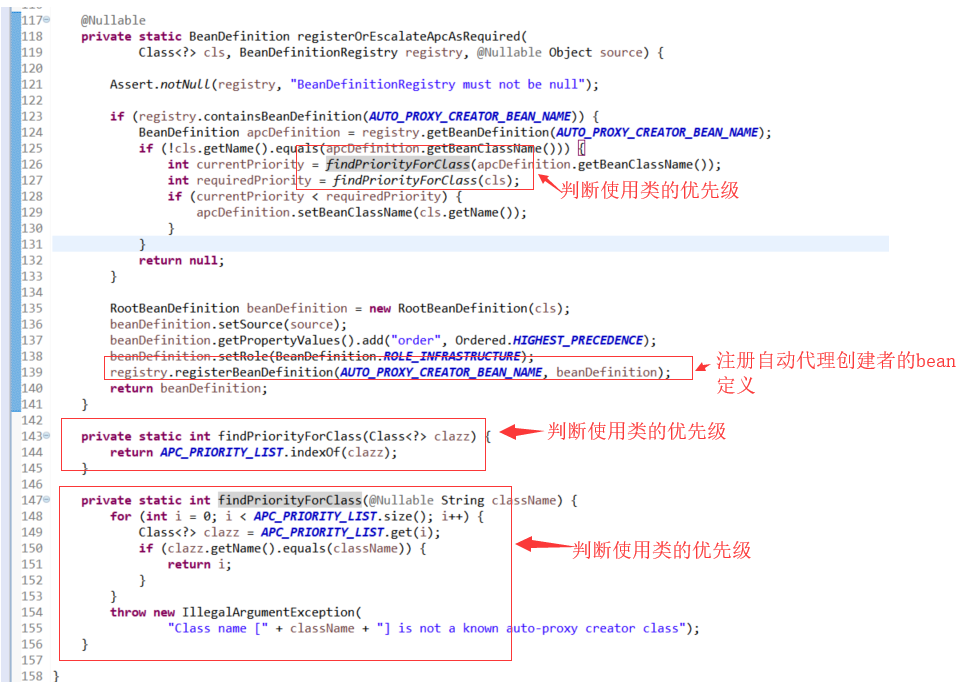
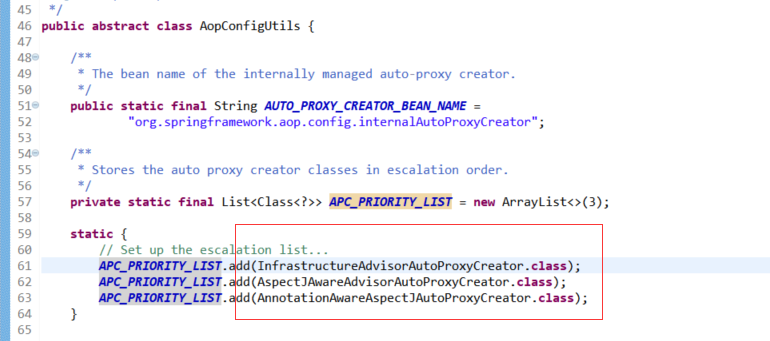
说明:
org.springframework.aop.framework.autoproxy.InfrastructureAdvisorAutoProxyCreator现在已经不使用了
org.springframework.aop.aspectj.autoproxy.AspectJAwareAdvisorAutoProxyCreator对应于AspectJ的xml方式
<aop:config> <aop:pointcut id="services" expression="execution(* com.study.leesmall.spring.sample.aop.*.service*(..))" />
<aop:aspect id="a1" ref="aspectAdviceBean" order="1">
<aop:before method="before1" pointcut-ref="doMethods" />
<aop:before method="before2" pointcut-ref="doMethods"/>
<!--args(tk,..)有两个意思,第一个意思是被增强的方法的第一个参数的类型要和before3的参数tk的类型一样
第二个意思是被增强的方法的第一个参数tk要赋值给before3的参数tk;
arg-names="" 当不能确定方法参数的顺序时可以用这个参数指定arg-names="param1,param2"
-->
<aop:before method="before3" pointcut="execution(* com.study.leesmall.spring.sample.aop.*.do*(..)) and args(tk,..)" arg-names=""/>
<aop:before method="before4" pointcut="execution(* com.study.leesmall.spring.sample.aop.*.do*(..)) and args(tk,ti)"/>
<aop:around method="arround1" pointcut-ref="services"/>
<aop:around method="arround2" pointcut="execution(* com.study.leesmall.spring.sample.aop.*.service*(..)) and args(name)"/>
<aop:after-returning method="afterReturning" pointcut-ref="services" returning="retValue"/>
<aop:after-throwing method="afterThrowing" pointcut-ref="services" throwing="e"/>
<aop:after method="after" pointcut-ref="services"/>
</aop:aspect>
</aop:config>
查看org.springframework.aop.aspectj.autoproxy.AspectJAwareAdvisorAutoProxyCreator的继承体系:
父类:
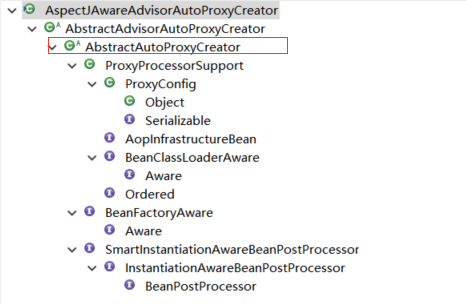
子类:

查看org.springframework.aop.framework.autoproxy.AbstractAutoProxyCreator的继承体系,搞清楚它继承实现了什么,他的父类和子类有哪些
父类:
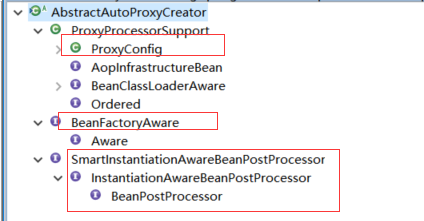
子类:

org.springframework.aop.aspectj.annotation.AnnotationAwareAspectJAutoProxyCreator对应于AspectJ的注解方式:
<bean id="aspectAdviceBeanUseAnnotation" class="com.study.leesamll.spring.sample.aop.AspectAdviceBeanUseAnnotation" /> <aop:aspectj-autoproxy></aop:aspectj-autoproxy>
<aop:config proxy-target-class="false" expose-proxy="false">对应代码:
org.springframework.aop.config.AopNamespaceUtils.registerAspectJAutoProxyCreatorIfNecessary(ParserContext, Element)
->
org.springframework.aop.config.AopNamespaceUtils.useClassProxyingIfNecessary(BeanDefinitionRegistry, Element)

2)两种配置方式(advisor和aspectJ)解析之后都是向Bean工厂注册了Pointcut和Advisor的Bean定义
b)aop:aspectj-autoproxy开启AspectJ注解支持
1)注册了autoProxyCreator的Bean定义,它是一个ProxyConfig、BeanFactoryAwrare、BeanPostProcessor
org.springframework.aop.config.AopNamespaceHandler.init()
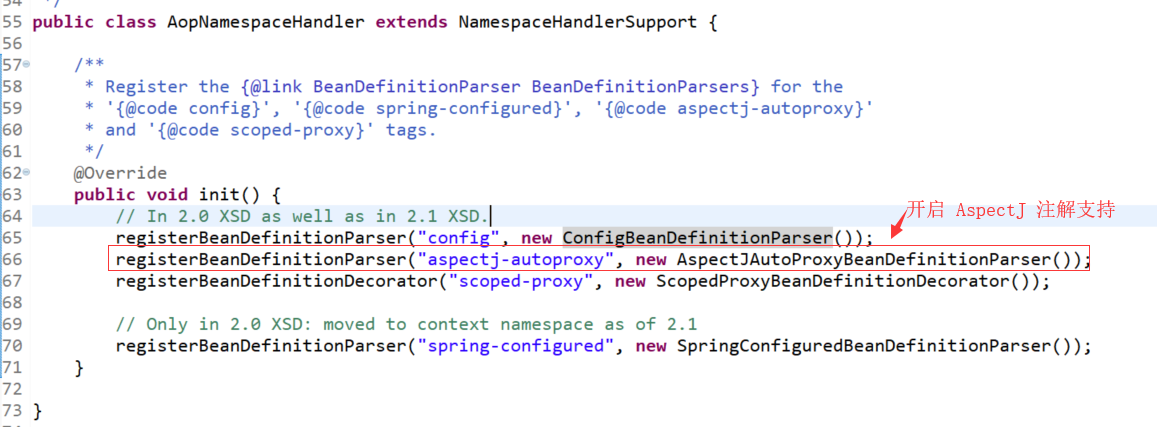
org.springframework.aop.config.AspectJAutoProxyBeanDefinitionParser
org.springframework.aop.config.AspectJAutoProxyBeanDefinitionParser.parse(Element, ParserContext)
org.springframework.aop.config.AopNamespaceUtils.registerAspectJAnnotationAutoProxyCreatorIfNecessary(ParserContext, Element)

<!--开启AspectJ注解的支持 --> <aop:aspectj-autoproxy>
<!-- 满足name里面的表达式(bean名称的表达式)的才进行切面的处理 -->
<aop:include name="bean名称的表达式"/>
</aop:aspectj-autoproxy>

<aop:include name="bean名称的表达式"/>对应源码:
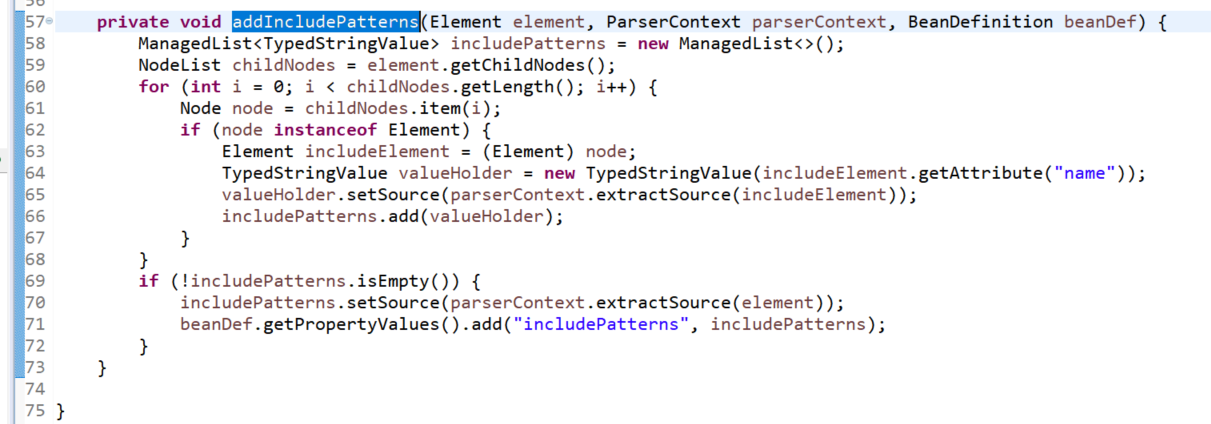
c)AspectJ注解的切面在哪里读取加载的?
可能的地方:
BeanDefinitionRegistryPostProcessor x
BeanFactoryPostProcessor x
InstantiationAwareBeanPostProcessor Bean 实例创建前后
BeanPostProcessor
Xml方式的解析:
org.springframework.aop.aspectj.autoproxy.AspectJAwareAdvisorAutoProxyCreator
注解方式的解析:
org.springframework.aop.aspectj.annotation.AnnotationAwareAspectJAutoProxyCreator
两者的关系:
public class AnnotationAwareAspectJAutoProxyCreator extends AspectJAwareAdvisorAutoProxyCreator
org.springframework.aop.aspectj.annotation.AnnotationAwareAspectJAutoProxyCreator.findCandidateAdvisors()

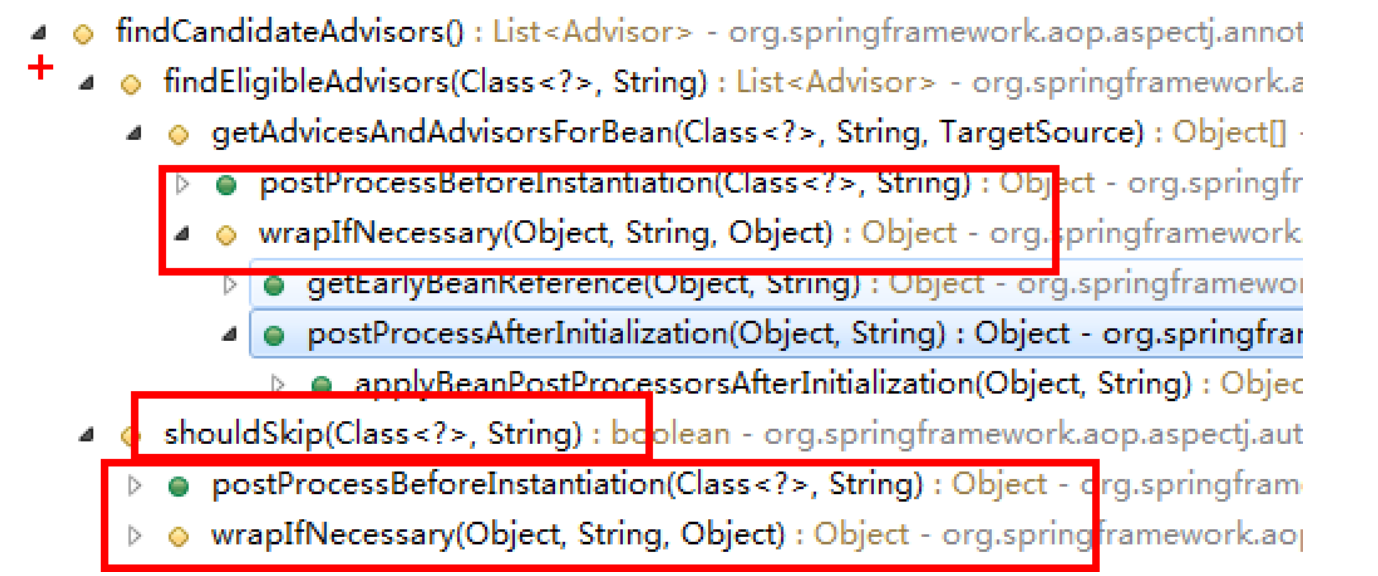
BeanFactoryAspectJAdvisorsBuilder.buildAspectJAdvisors() 中完成了注解的读取、Advisor对象的创建及缓存。
org.springframework.aop.aspectj.annotation.BeanFactoryAspectJAdvisorsBuilder.buildAspectJAdvisors()

org.springframework.aop.aspectj.annotation.ReflectiveAspectJAdvisorFactory.getAdvisors(MetadataAwareAspectInstanceFactory)

2、 看织入的过程
a) 在哪里做的织入?
在org.springframework.aop.aspectj.annotation.AnnotationAwareAspectJAutoProxyCreator.findCandidateAdvisors()里面打个断点拿到调用栈
入口:
com.study.leesmall.spring.sample.aop.AopMainUseAspectAnnotation

b) 如何判断 Bean 要不要被创建代理?如何排除 advice Bean 的?
排除 advice Bean :
跳过advice bean 跳过带有@Aspect注解的自己,不能自己为自己创建代理,否则进入死循环,如AspectAdviceBeanUseAnnotation
org.springframework.aop.aspectj.autoproxy.AspectJAwareAdvisorAutoProxyCreator.shouldSkip(Class<?>, String)


再次进来,是在 PostProcessAfterInitialization()

创建代理的方法:
org.springframework.aop.framework.autoproxy.AbstractAutoProxyCreator.wrapIfNecessary(Object, String, Object)
如何判断 Bean 要不要被创建代理:
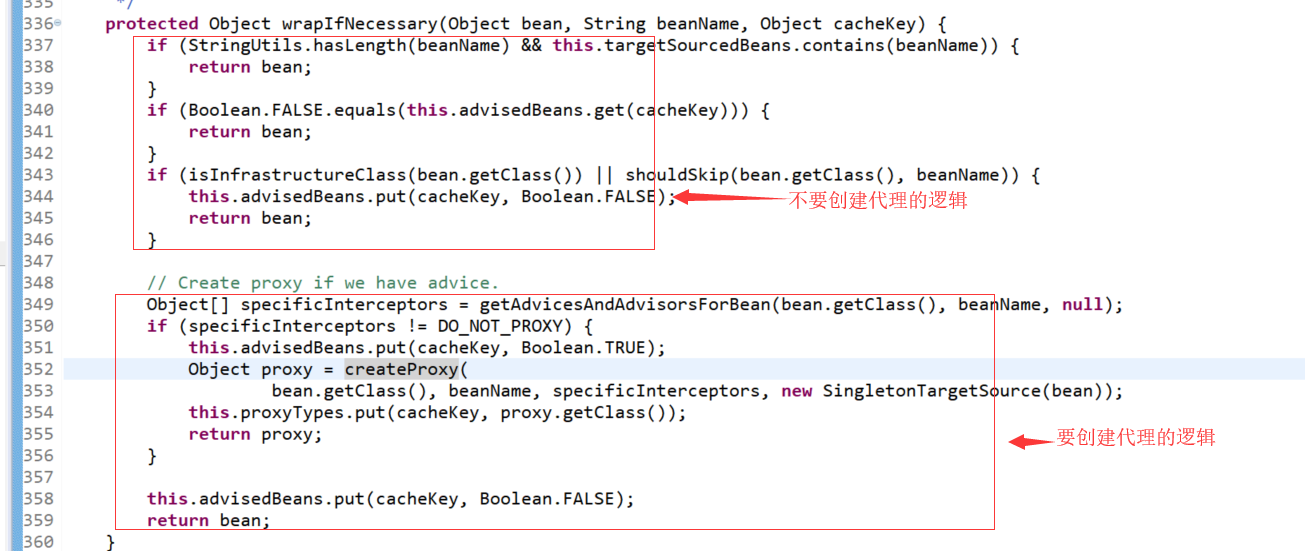
c)如何选择 jdk动态代理 还是cglib的动态代理
org.springframework.aop.framework.autoproxy.AbstractAutoProxyCreator.createProxy(Class<?>, String, Object[], TargetSource)
org.springframework.aop.framework.ProxyFactory.getProxy(ClassLoader)
org.springframework.aop.framework.ProxyCreatorSupport.createAopProxy()
org.springframework.aop.framework.DefaultAopProxyFactory.createAopProxy(AdvisedSupport)
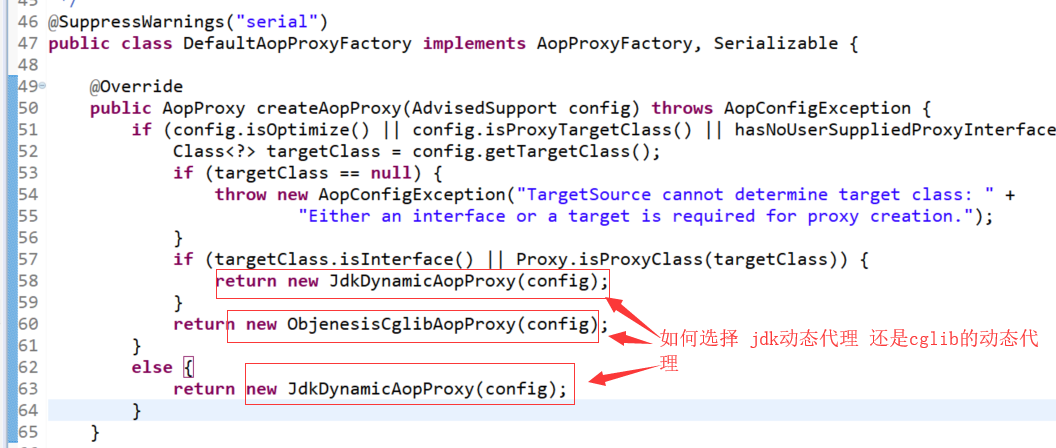
d) 如何来创建代理的,涉及哪些类,如何协作的。
AutoProxyCreator
ProxyConfig ProcxyFactory
AopProxyFactory
AopProxy
3 、看方法被调用时的增强过程
a) 在代理中如何决定对当前方法合格的 advice 的?
调用的 Advisor 中 Pointcut 进行匹配
b) 如何组织多个 advice 执行的?
责任链模式
org.springframework.aop.framework.JdkDynamicAopProxy.invoke(Object, Method, Object[])
org.springframework.aop.framework.ReflectiveMethodInvocation.proceed()
4、源码对应的类图
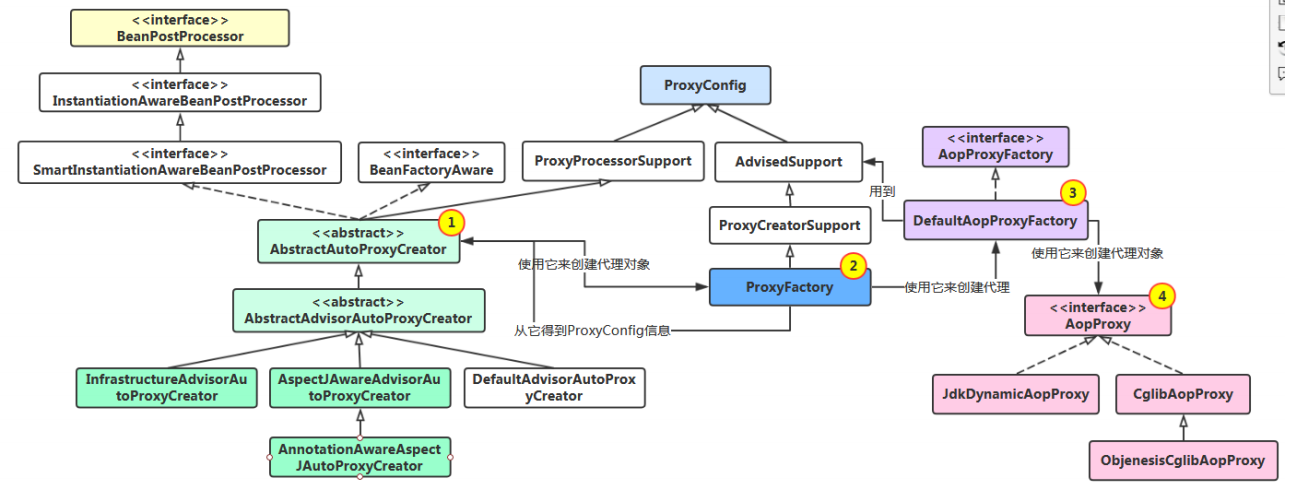
本文内容总结:一、AOP的核心概念回顾,二、Spring中AOP的用法,1. 传统Advisor方式,2. Aspect语法方式,Aspect的advice是基于方法的。,3. AspectJ注解方式,三、Spring AOP 源码学习,1、spring aop的工作流程是怎样?以传统的Advisor配置为例进行思考,2. 源码阅读思路,1、先看配置解析,看标签解析过程都做了什么、完成了什么。,2、 看织入的过程,3 、看方法被调用时的增强过程,4、源码对应的类图,
原文链接:https://www.cnblogs.com/leeSmall/p/10236553.html
以上是 框架源码系列十:Spring AOP(AOP的核心概念回顾、Spring中AOP的用法、Spring AOP 源码学习) 的全部内容, 来源链接: utcz.com/z/296657.html






